Tesla Supercharger network: complete guide to Tesla charging stations
The Tesla Supercharger network is expanding fast, providing rapid charging throughout the UK to Tesla and non-Tesla owners
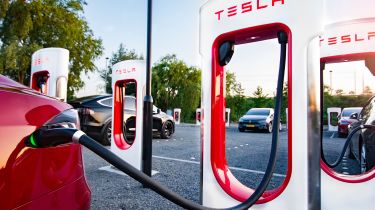
When travelling around the country there’s a good chance you’ve seen a Tesla Supercharger station tucked away in a corner of the car park. These distinctive red and white charging points seem to be everywhere now, with more than 1,400 Superchargers spread across 140 locations throughout the UK as of April 2024.
Tesla wants to make things easier for EV drivers and plans are in place to open many more Superchargers in the UK and abroad. Currently there are 55,000 chargers worldwide with plans in place to increase that to 70,000 by the end of 2024.
Until May 2022, the Tesla Supercharger network could only be used by Tesla vehicles like the Model 3, Model S, Model Y and Model X, however there are now 42 sites available to all EVs across the UK, with each one containing multiple chargers. This is an increase from when Tesla originally opened up 15 sites, with a combined 158 chargers, to all EV drivers in May 2022 and there are many more Superchargers planned to be built.
All of the new V4 Tesla Superchargers that are built will be available to everyone with a compatible car. If you would like to use any other car on the Supercharger network it will just need a CCS (Combined Charging System) compatible socket, which is the one fitted to the majority of production cars, today.
Despite allowing other brands some access, having full access to the entire Supercharger network remains one of the biggest perks of Tesla ownership. Especially if you cover a lot of miles as it provides a reliable way to keep your Tesla topped up while out on the road. It can be a lot cheaper too, some Teslas can even use the Superchargers for free. Keep reading to learn all that you need to know about the Tesla Supercharger network.
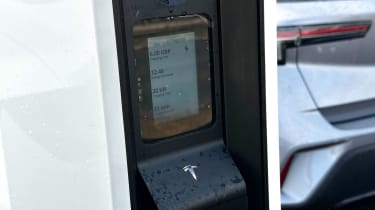
How much does it cost to use a Tesla Supercharger?
Unlike other rapid-charging networks which have set pricing for all their chargers, Tesla Supercharger rates vary between each location and in 2022, Tesla rolled out a flexible price model that sees rates change at certain times of the day.
According to electric-car charging website ZapMap, Tesla owners in the UK can expect to pay an average of 43p/kWh during peak hours (generally between 4-8pm), and slightly less during non-peak periods. Of course, this is all subject to change and exact pricing can be found by selecting any of its chargers on a Tesla’s in-car sat-nav system. When your charging session is complete, an estimate of the final cost will be shown on the car's screen, and can also be reviewed in an owner’s online account.
How to use a Tesla Supercharger
If you’re a Tesla owner, using a Supercharger is really simple. So long as you’ve got a payment method set up, just locate a convenient station using your Tesla’s infotainment system or the company’s app, then park up and plug in, it’s as easy as that. A green light will flash on your Tesla's charging port to indicate that charging has begun, and you can monitor the progress of a charging session on your car's infotainment screen. If you don't want to sit in the car while it charges, you can get the same information on the Tesla smartphone app.
Can other cars use Tesla Superchargers?
Given Superchargers are so common, you’ll probably be wondering: “do Tesla chargers work on other cars?”. Until recently, the Tesla Supercharger network was exclusively available to owners of the company’s cars. However, thanks to the introduction of a new pilot scheme, as well as the new V4 generation of Superchargers, the network is slowly opening up to more and more EV drivers.
With 25 locations in the UK now taking part in the Non-Tesla Supercharger Pilot scheme, non-Tesla owners can expect to pay more for a charge – the average currently ranges between 53p-64p per kW, according to ZapMap.
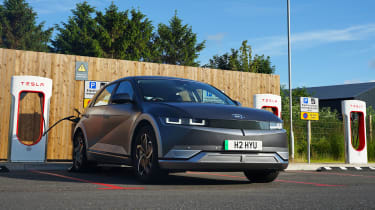
However, Tesla has recently unveiled its new V4 Supercharger which, from the outset, will be available to all electric cars with a CCS charging port. Fitted in-line with new electric-car charging regulations, the V4 Supercharger boasts a screen to display the cost of charging in pence-per-kilowatt-hour, as well as other useful information such as the current rate of charge.
More important, however, is the V4 Supercharger’s contactless payment terminal which means you don’t have to download Tesla’s app to pay. If you’re using one of the older V3 units taking part in the pilot scheme then you will, unfortunately, have to download the app and sign up for a free Tesla account in order to pay.
There is an optional membership fee which was reduced from £10.99 a month to £8.99 a month or £90 a year in April 2024. This unlocks cheaper rates in line with what Tesla owners will pay. Again, exact pricing is available to view on the Tesla app; you may find using the network regularly quickly offsets the cost of membership.
Tesla Supercharger cable
Up until recently, all of Tesla’s Superchargers were equipped with a Type 2 cable and a CCS cable (above). Both will enable DC rapid charging, ensuring quick charging times whichever model you drive. The Type 2 cables are for pre-facelift Model S and Model Xs, while the CCS cable can be used with almost every new electric car you can buy today, including the Model 3 and Model Y.
The latest V4 Tesla Superchargers only come with a CCS charging cable, though. Thankfully, older Model S and Model Xs can be retrofitted with a CCS adapter at an extra cost, which will enable them to rapid charge at V4 stations, as well as other, non-Supercharger locations.
Tesla charging time
Most Tesla Superchargers offer rapid charging speeds of up to 150kW and are known as V2 units, however, the latest V3 and V4 Superchargers can charge at up to 250kW. Plug your Model 3 or Model Y into one of these units, and a 10-80% top-up will take just over half-an-hour. This equates to around 172 miles of range in just 15 minutes in the right conditions.
Improvements for the older Model S and Model X with the latest Superchargers are more modest as these cars aren't equipped with the necessary CCS charging port as standard. Instead, their maximum charging rate climbs to 145kW when using a V3, which is still very fast in the scheme of things. Thankfully, both the Model S and Model X have recently been updated, and will come with CCS charging ports from now on – a good thing as the newest V4 units only come with a CCS cable.
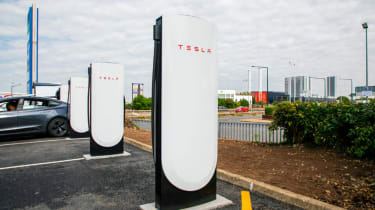
Despite the latest V4 charging points, the Tesla Supercharger network is no longer the fastest out there. The IONITY rapid-charging network and Gridserve’s Electric Highway network both feature units capable of 350kW charging speeds, plus there are other companies which have plans in place to install charging points capable of 400kWh and upwards.
Tesla says the V4 units – which currently operate at the same 250kW rate as the outgoing V3s – are capable of much higher speeds. Elon Musk’s firm remains tight-lipped about exactly how fast they are and when we can expect them to be turned up.
That said, there are a limited number of 350kW charging points online right now, and there are currently no electric cars on sale that can make use of its maximum speed. The only ones that come close are the Porsche Taycan which can charge at 320kWh, the Audi e-tron GT and Maserati GranTurismo Folgore can both charge at up to 270kW. Meanwhile, the Hyundai Ioniq 5, Kia EV6 and Genesis GV60 max out at around 230 to 240kW.
Tesla also points out that its Superchargers won’t always deliver full speed: the rate you experience could drop depending on your battery level (it takes longer to charge the last 20% of a battery than the first 20% from empty), the number of cars using the Supercharger station at the time, and also the temperature on the day; freezing temperatures in winter can reduce charging speeds and make waiting times longer.
Free Supercharger miles
Certain examples of the Tesla Model S and Tesla Model X on the road come with unlimited, free access to the Supercharger network, although it's not always easy to tell which ones qualify, as the company has ended and then reinstated the offer several times.
Any Model S or Model X bought before 2 November 2018 had (and continues to have) free, unlimited access to the Supercharger network. Cars sold between then and August 2019 were given an annual allowance which equates to 400kWh of free Supercharging. After the credits are used up, users have to pay to use the network.
However, in August 2019 Tesla reinstated unlimited free Supercharging as part of the Model S and Model X sales package. This continued until the end of May 2020, when the perk was again withdrawn. Our advice would be to check whether free Supercharging is included before you buy the car.
You could also get free Supercharger miles by referring friends or family to Tesla who subsequently bought one of the company’s electric cars, although these did have an expiration date, which you can view on the Tesla app. This programme has also been removed.
Tesla Supercharger idle fees
Tesla noticed an issue with people leaving their cars on charging stations long after they had finished charging so the firm brought in a scheme to stop this happening. If a Supercharger station is at least 50% occupied, leaving your car plugged in after it has been fully charged will result in an 'idle fee'. In the UK, Tesla charges owners 50p for every extra minute the car is left in the charging bay after it has finished charging.
If a station is 100% full, this rises to £1 per minute. Tesla insists it doesn’t want to make any money from idle fees, and that the policy is in place simply to encourage users to free up charging bays for others as promptly as possible. If you move your car within five minutes of reaching a full charge, no idle fee will be charged.
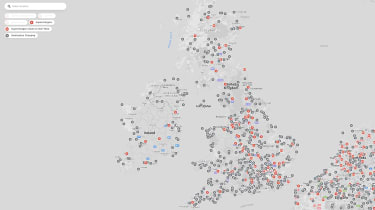
Tesla Supercharger map
Most Tesla Superchargers are located at motorway service stations, which makes long-distance, electric-powered travel across the country a very realistic prospect. If you use Tesla’s sat nav to plan a long journey, the system will automatically work out the best route to take, factoring in the ideal stations to stop and recharge along the way.
In the world there are now more than 55,000 Superchargers, spread across more than 40 countries. More than 1,400 of those chargers can be found at sites in the UK, with many now accessible to non-Tesla owners as well. If you want to find out where any of these chargers are, you can check the Tesla app, the in-car sat-nav, or the Supercharger website.
The Tesla Supercharger map also shows you where you can find 'destination' chargers, which offer slower charge speeds for overnight top-ups. These are usually located in car parks or outside hotels; anywhere you’d expect to be parked for a few hours or more. Because they’re designed to charge Teslas over a longer period of time, the destination chargers aren’t as fast as the Superchargers. Anywhere between 7kW and 22kW is possible at AC-connected sites, which means a typical Model 3 Standard Range would take around five and a half hours to fully charge.
